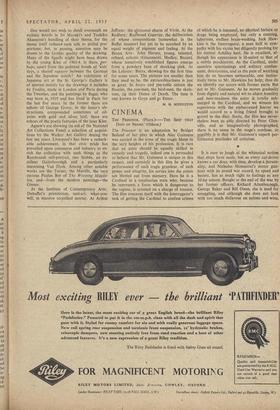ART
THE Hiroshima panels to be seen at the Col- lege of Preceptors in Bloomsbury Square are the most interesting paintings to have come out of Japan in recent years. They are not, to my eye, of equal quality. The studies for them are mostly intensely moving; but the cyclical form of the panels themselves seems to dis- perse some of the energy which went to their making into a not wholly resolved flux and flow. The most successful, Fire, is also the most violent and harsh, yet observes dis- passionately the beauty of the flickering flames that lick and curl about the doomed. This is surely the most profound protest against war since Guernica. One would not wish to dwell overmuch on stylistic details in In Maruki's and Toshiko Akamatsu's handling of their theme, for the theme itself reducest such talk to pitiful pro- portions; but, in passing, attention may be drawn to the Gothic quality of the drawing. Many of the figutis might have been drawn by the young Klee of 1903-4. Is there, per- haps, apart from the political bonds of 'axis' days, a shared rapport between the German and the Japanese minds? An exhibition of Japanese art at the St. George's Gallery is of interest mainly for the drawings it includes by Foujita, made in London and Paris during the Twenties, and the paintings by Sugai, who was born in 1919 and has lived in Paris for the last five years. In the former there are echoes of George Grosz; in the latter's ab- stractions, compounded sometimes of oil- paint with gold and silver leaf, there are echoes of the poetic fantasies of the later Klee.
Agnew's are showing (in aid of the National Art Collections Fund) a selection of acquisi- tions by the Walker Art Gallery during the last ten years. Liverpool's has been a remark- able achievement, in that civic pride has prevailed upon commerce and industry to en- rich the collection with such things as the Rembrandt self-portrait, two Stubbs, an ex- cellent Gainsbormigh and a particularly interesting Van Dyck. Among other notable works are the Turner, the Murillo, the very curious Paulus Bor of 'The Weeping Magda- len, and—from the modern paintings—the Ginner.
At the Institute of Contemporary Arts: Dubuffet's primitivism, anti-art, what-you- will, in massive scratched mortar. At Arthur
Jeffress : the sloispnne charm of Vivin. At the Redfern: Raymond Guerrier, the deliberation of whose compositions (somewhat in the Buffet manner) has yet to be matched by an equal weight of pigment and feeling. At the Beaux Arts : John Hersey, young, talented, refined, eclectic (Giacometti, Medley, Bacon), whose tentatively established figures emerge from a powdery haze of shocking pink. At the Lefevre: Burra, showing for the first time for some years. The pictures are smaller than they used to be, the extraordinariness is just as great. In bistro and pin-table saloon the floozies, the, con-men, the bird-men, the skele- tons, jig their Dance of Death. The tune is one known to Goya and 40 Ensor.
M. H. MIDDLETON











































 Previous page
Previous page